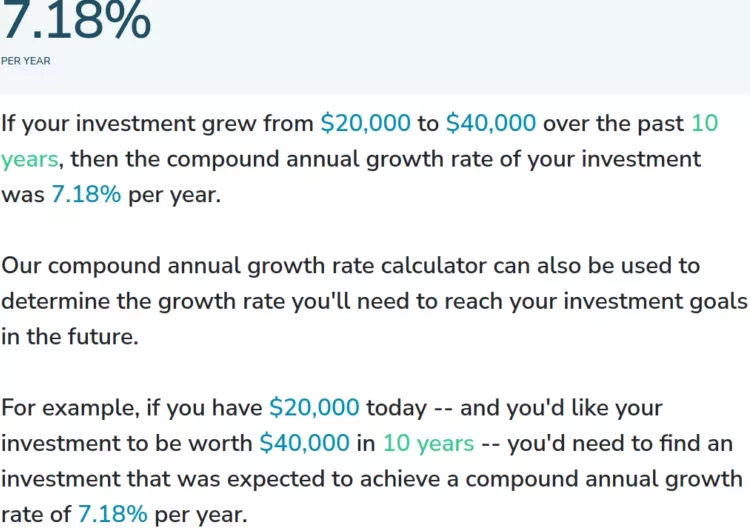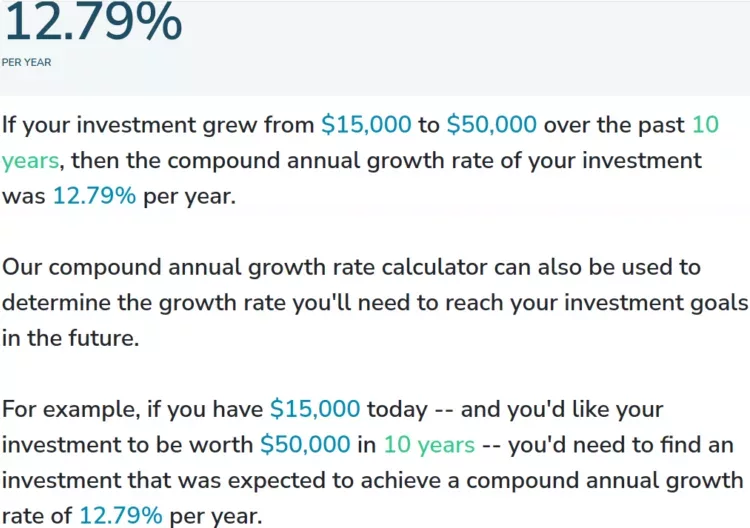How Does the Return on Investment (ROI) Calculator Work?
The purpose of the Return on Investment Calculator is to determine both the total and annualized return on your investment based on a future projected value. It represents the annual return projected based on a given – or hoped-for – outcome.
It answers the question, if I invest $1,000 today and it grows to $2,000 over 10 years, what would be the return on investment?
As you might imagine, that hardly means the expected return will be guaranteed. But it does create a target return you’ll need to achieve your end goal.
Conversely, the calculator can be used to determine the ROI on an investment you made in the past.
We’ll work examples of both in the next section.
The Return on Investment Calculator is one of the simpler calculators in the financial space. It requires you to provide only five pieces of information:
Amount Invested
Amount Returned (actual or expected)
Investment Time – using dates or length (in years)
Beginning Date (From)
Ending Date (To)
Example of Return on Investment (ROI) Calculator
To show you how the Return on Investment Calculator works, let’s go through two examples. The first will determine the ROI we’ll need to reach a certain investment goal. The second will determine the ROI on an investment we’ve already made.
Calculating a Future Desired ROI
We want to know what rate of return we’ll need to turn $20,000 into $40,000 in 10 years.
Using the calculator to make that determination, we input the following information:
Amount Invested – $20,000
Amount Returned – $40,000
Investment Time – using dates
Beginning Date (From) – August 6, 2021
Ending Date (To) – August 6, 2031 (10 years)

The calculator shows we’ll need an annualized ROI of 7.18% to reach the goal of doubling $20,000 to $40,000 in 10 years. (Or 7.18% will be the annual rate or return if we reach our investment goal).
Armed with that ROI target number, we can construct a portfolio designed to (hopefully) generate that return.
Calculating ROI On an Investment
The Return on Investment Calculator can also be used to calculate the ROI on an investment already made.
For example, let’s say you invested $15,000 in an exchange traded fund (ETF) 10 years ago, and it’s risen to $50,000 – what was the ROI on that investment over 10 years?
We’ll enter the following information:
Amount Invested – $15,000
Amount Returned – $50,000
Investment Time – using dates
Beginning Date (From) – August 6, 2011
Ending Date (To) – August 6, 2021
To keep things simple, we’ll assume any dividends paid by the ETF have been reinvested in the fund, rather than paid out as cash.
Here are the results:

Based on the results of the calculator, we see that our investment of $15,000 in 2011 had a net gain of $35,000 and grew at an annualized ROI of 12.79% over the past 10 years.
You can compare that return on investment with different benchmarks, like the return on the S&P 500 index over the same time period. That will help provide an indication of how well the investment has performed.
If the fund outperformed the chosen benchmark, we made a good investment. But if it underperformed the index, you might want to explore what caused the underperformance. It could have been the result of high fees on investment decisions made by fund management.
What is Return on Investment (ROI)?
We’ve just demonstrated what the Return on Investment Calculator does and provided a couple of examples of how you can use it. But using the calculator to determine your ROI may not be important until you better understand what return on investment actually is.
We’re going to provide a high-level explanation here, but we have a more in-depth discussion of the topic in our Return on Investment (ROI) page.
The simplest explanation is that ROI is a ratio that measures the gain or loss on investment.
More specifically, you’ll need to determine that ratio with investments where it’s not entirely clear. For example, if you invest in a certificate of deposit (CD), the bank will provide an annual percentage yield (APY) that will tell you exactly what the ROI on the CD will be. More calculations are unnecessary.
But if you’re investing in a risk-type asset, like a company stock, a mutual fund, or exchange traded fund, you’ll need to calculate a projected return to reach an expected investment goal in a specified time period.
By providing both an initial investment and a future projected value, the ROI will tell you how much the investment will have to earn. At the opposite end of the spectrum, you can determine the ROI on investment you’ve made in the past.
ROI Formula
Though the Return on Investment Calculator does the math for you, it can help to know the formula the calculator uses.
That is expressed as follows:
Net Gain (or loss) divided by Initial Investment X 100 = ROI
Return on Investment Example
By inserting real numbers into the calculation, we can get an ROI that looks something like this:
$250,000 (net gain) divided by $100,000 (initial investment) = 2.5 or 250% (ROI)
In the above example, the initial investment of $100,000 produced a total ROI of 250%, growing to $350,000 and returning a $250,000 profit at the end of the investment term.
The Return on Investment Calculator performs one additional calculation, by providing the annualized ROI based on the number of years it took for the initial investment to grow to the net value.
How to Use ROI to Make Investment Decisions
Ideally, an investment should provide a positive return. If you invest $10,000 in a company stock, or $50,000 in a piece of equipment for your business, ROI can help you determine if the investment will be worth making.
For example, disclosures for an ETF may show an investment of $10,000 made 10 years ago has grown to $100,000 today; that may help you make a decision to invest in the fund, but remember past performance is never a guarantee of future returns.
When it comes to financial investments, past returns provide nothing more definite than a loose projection of what is possible based on past events.
ROI may be more useful with tangible investments, like business equipment or machinery, or real estate.
An Investment Real Estate Example
The situation is similar with real estate. Let’s say you’re deciding whether to buy a $250,000 investment property, which will require an initial out-of-pocket investment of $50,000.
Because investment real estate has so many moving parts, you’ll need to calculate ROI to decide if the property is worth buying. In doing so, you’ll need to calculate the expected annual net rent income of the property as well as the expected capital appreciation.
If you expect net rental income (after all property expenses are accounted for) to average $1,500 per year for the next 20 years ($30,000), and for the property to double in value over that same time period, you may determine the total return you’ll earn on your $50,000 investment over 20 years is worth making.
But there’s another important component of determining ROI that can help you make a decision to invest or not.
Determining the ROI of an investment gives you the ability to compare that return with other investments.
For example, if you’re considering an investment that’s likely to double in value in the next 10 years, you may decide not to invest because there’s another opportunity likely to triple your investment in a decade.
RELATED: The 10 Best Real Estate Crowdfunding Sites
Limitations of ROI
As helpful as ROI is, it does have several limitations:
Expected returns are usually projections, not certainties. A lower-than-expected return can change the entire outcome. With certain investments, specific returns are no more than educated guesses.
Risk and return are intrinsically linked. To get higher returns you must increase the risk you’re willing to bear to get those returns. There’s no free lunch, and no way to get higher returns without a corresponding increase in risk and the potential for losing money.
Unexpected costs related to the investment. This is more likely to happen with tangible investments, like business equipment and real estate.
Accounting for taxes with ROI can be complicated and is often disregarded.
Returns can be inconsistent, with the most generous ones coming toward the end of the term, and even losses occurring early on. A positive ROI could mask the risk of an investment in the early years.
Though our calculator takes time into consideration, strict interpretations of ROI often don’t. That holds the potential for an investment that provides 10% per year over the next five years, compared with one that will provide a total return of 60% over the same timeframe. If time is ignored, that type of comparison doesn’t happen.
Summary
When deciding whether to make an investment, ROI is just one metric you should consider. In situations where a business asset is necessary to your business – even though it doesn’t provide a positive ROI – you may still need to buy it.
Calculate ROI on any investment you’re considering buying, with full knowledge of the limitations involved.
Ask An Expert: What is a Good ROI?
If you’re investing in a mutual fund that invests in tech stocks, you should compare the performance of that fund against an appropriate and recognized benchmark. In this case, you can compare the performance of the fund against the NASDAQ-100 technology sector Index (NDXT).
If the fund has had a cumulative return of 75% over the past 10 years, but the NDXT has returned 100%, the fund may not be a terrible investment, but is underperforming its industry sector.
After calculating ROI on an investment, you should compare that return with those provided by alternatives. In the example of business equipment, you may want to evaluate other products, even after determining your first choice has a positive ROI.
You should then compare the expected performance of investment alternatives. For example, if a piece of business equipment is expected to provide a 7% return over the next 10 years, but you can also earn a risk-free return of 3% by investing in 10-year U.S. Treasury notes, you may decide the equipment is not worth the extra risk.
That doesn’t necessarily mean you won’t be looking for that type of business equipment. Instead, you may expand your search to include competing business equipment likely to provide a higher rate of return than the risk-free return on 10-year U.S. Treasury notes.
Finally, you may want to figure your own risk tolerance into the mix. If an investment has the potential to rise by 100% over the next 10 years, but an equally likely potential to lose 50%, you may choose to invest in a lower risk, lower reward alternative.
In the end, it’s not all about the numbers provided by the ROI, even though it is a good place to start.


